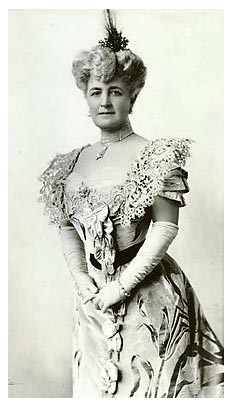

It is said that we meet those we are destined to meet in life. Whether it is a chance encounter on a train to a lady seated wearing pearls, or a gentleman who asks us to dance, we are all in a cosmos that clearly defines our circumstances. We still have a choice to engage, or not to engage.
So it was with Bertha Honore who was a shy 13 when Mr. Potter Palmer noticed her against the background of ancestral French furniture in her father’s Chicago home. Potter was 36. Bertha had been born in Louisville, Ky. May 22, 1849. She was known in her home town as a musician, linguist, writer, politician, and administrator.
No sooner than the end of the Civil War in 1865 and the news of the assassination of president Abraham Lincoln, did Bertha see the funeral train pass through Chicago on its way to Springfield. It was that Fall she entered the Convent of the Visitation in Georgetown. She paid a proper visit to bid Potter Palmer goodbye because he was going to Europe for his health.
She was graduated in 1867 with highest honor in 19 subjects including history, literature, algebra, and chemistry. After her debut, Potter began sending flowers. Lots of bouquets. So it was in 1870 when the Palmer House was completed, and Bertha was 21, she wed Potter Palmer. His wedding gift to her was the $3,500,000 Palmer House.
That one October night in 1871when Chicago was engulfed in flames, Bertha said that “Chicago will rise again.” She was a force to be reckoned with to be sure. She was a member of the Chicago Woman’s Club. She worked with Jane Addams and the Hull House. She held meetings in her home for factory girls and learned about their lives. She bore two sons, Potter and Honore.
They together built a castle home facing the lake and looking toward Lincoln Park. It cost them more than one million dollars. Bertha knew how to spend vast sums of money!
The World’s Columbian Exposition om 1893 in Chicago had Bertha Palmer as president of the National Board of Lady Managers. She travelled through Europe to contact heads of state and by the time she stepped off the Normania in July 1891, 41 countries were committed to exhibit in the Woman’s Building.
The contest to design the Woman’s Building was open only to women. Sophia G. Hayden, a graduate of MIT and 21 years old, won. She was the first woman in the U.S. to design an important public building. Bertha liked her plans, but did request that she add a roof garden. It was said at the time that Bertha was “beautiful, dashing, quick and smart, she was sure of herself,” wrote historian Ernest Poole.
Just as Bertha drove a golden nail into the Women’s Building, Potter said to his wife ”You were magnificent.” Bertha wore a gown of yellow satin and velvet. Her dark hair was crowned with a diamond tiara. The music of the “Coronation March” was played by Sousa’s band.
The Palmer collection of Impressionist art included 29 Monets and 11 Renoirs. Those works form the core of the Art Institute collection today. She had homes in London and Paris and traveled throughout Europe dining with kings and mixing with industrialists and statesmen. Bertha bought more than 100,000 acres of land in and around Sarasota, Fla.. Bertha proved to be quite astute for her young age and saw success as a businesswoman, socialite and philanthropist.
Her entire life and her fixed ambition was to promote Chicago in both financially and cultural efforts. She was a wealthy woman who spent money with zeal for the public welfare. Bertha Honore Palmer died May 5, 1918 when she was 69 years of age in Osprey, Fla.. Her remains rest at Graceland Cemetery in Chicago.

